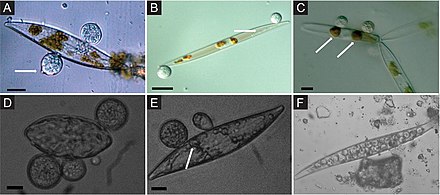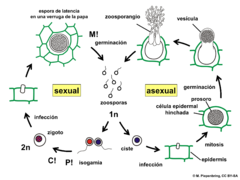Chytridiomycota
| Chytridiomycota | |
|---|---|

| |
| Sporangium of a spizellomycete | |
| Scientific classification | |
| Domain: | Eukaryota |
| Kingdom: | Fungi |
| Division: | Chytridiomycota Hibbett et al. (2007) |
| Classes/orders | |
| |
Chytridiomycota are a division of
Chytrids are
Classification
Species of Chytridiomycota have traditionally been delineated and classified based on development, morphology, substrate, and method of zoospore discharge.[7][4] However, single spore isolates (or isogenic lines) display a great amount of variation in many of these features; thus, these features cannot be used to reliably classify or identify a species.[7][4][8] Currently, taxonomy in Chytridiomycota is based on molecular data, zoospore ultrastructure and some aspects of thallus morphology and development.[7][8]
In an older and more restricted sense (not used here), the term "chytrids" referred just to those fungi in the class Chytridiomycetes. Here, the term "chytrid" refers to all members of Chytridiomycota.[2]
The chytrids have also been included among the
In older
The class
- The order Blastocladiales, originally within the Chytridiomycota, are now classified as a separate phylum, the Blastocladiomycota.[16]
- The Neocallimastigales, originally an order of anaerobic fungi of the class Chytridiomycetes, found in the digestive tracts of herbivores, was later raised to a separate phylum, the Neocallimastigomycota.[15]
- The Olpidiomycota.[17]
Life cycle and body plan
Chytridiomycota are unusual among the Fungi in that they reproduce with zoospores.[4][18] For most members of Chytridiomycota, sexual reproduction is not known. Asexual reproduction occurs through the release of zoospores (presumably) derived through mitosis.[4]
Where it has been described, sexual reproduction of chytrids occurs via a variety of methods. It is generally accepted that the resulting zygote forms a resting spore, which functions as a means of surviving adverse conditions.
Sexual reproduction is common and well known among members of the Monoblepharidomycetes. Typically, these chytrids practice a version of oogamy: The male is motile and the female is stationary. This is the first occurrence of oogamy in kingdom Fungi.[3] Briefly, the monoblephs form oogonia, which give rise to eggs, and antheridia, which give rise to male gametes. Once fertilized, the zygote either becomes an encysted or motile oospore,[4] which ultimately becomes a resting spore that will later germinate and give rise to new zoosporangia.[3]
-
Life cycle of Batrachochytrium dendrobatidis
-
Life cycle of Synchytrium endobioticum in potato
-
Synchytrium endobioticum on potatoes.
Upon release from the germinated resting spore, zoospores seek out a suitable substrate for growth using
instead).Chytrids have several different growth patterns. Some are holocarpic, which means they only produce a zoosporangium and zoospores. Others are eucarpic, meaning they produce other structures, such as rhizoids, in addition to the zoosporangium and zoospores. Some chytrids are monocentric, meaning a single zoospore gives rise to a single zoosporangium. Others are polycentric, meaning one zoospore gives rise to many zoosporangium connected by a rhizomycelium. Rhizoids do not have nuclei while a rhizomycelium can.[3]
-
Types of chytrid thalli
-
Zoospore discharge from Phylctochytrium sp.
-
Sporangium and zoospores of the chytrid fungus B. dendrobatidis, under a scanning electron microscope
-
Chytrid sporangium and zoospores under the microscope
Growth continues until a new batch of zoospores are ready for release. Chytrids have a diverse set of release mechanisms that can be grouped into the broad categories of operculate or inoperculate. Operculate discharge involves the complete or incomplete detachment of a lid-like structure, called an operculum, allowing the zoospores out of the sporangium. Inoperculate chytrids release their zoospores through pores, slits, or papillae.[4]
Habitats
Chytrids are aquatic fungi, though those that thrive in the capillary network around soil particles are typically considered terrestrial.[7][4] The zoospore is primarily a means of thoroughly exploring a small volume of water for a suitable substrate rather than a means of long-range dispersal.[19]
Chytrids have been isolated from a variety of aquatic habitats, including peats, bogs, rivers, ponds, springs, and ditches, and terrestrial habitats, such as acidic soils, alkaline soils, temperate forest soils, rainforest soils, Arctic and Antarctic soils.[7][4] This has led to the belief that many chytrid species are ubiquitous and cosmopolitan.[7][4] However, recent taxonomic work has demonstrated that this ubiquitous and cosmopolitan morphospecies hide cryptic diversity at the genetic and ultrastructural levels.[20][21] It was first thought aquatic chytrids (and other zoosporic fungi) were primarily active in fall, winter, and spring.[4] However, recent molecular inventories of lakes during the summer indicate that chytrids are an active, diverse part of the eukaryotic microbial community.[22]
One of the least expected terrestrial environments the chytrid thrive in are periglacial soils.[23] The population of the Chytridiomycota species are able to be supported even though there is a lack of plant life in these frozen regions due to the large amounts of water in periglacial soil and pollen blowing up from below the timberline.
Ecological functions

Batrachochytrium dendrobatidis
The chytrid
Recent research has revealed that elevating salt levels slightly may be able to cure chytridiomycosis in some Australian frog species,[30] although further experimentation is needed.
Other parasites
Chytrids mainly infect algae and other eukaryotic and prokaryotic microbes. The infection can be so severe as to control primary production within the lake.[3][31] It has been suggested that parasitic chytrids have a large effect on lake and pond food webs.[32] Chytrids may also infect plant species; in particular, Synchytrium endobioticum is an important potato pathogen.[33]
Saprobes
Arguably, the most important ecological function chytrids perform is decomposition.[7] These ubiquitous and cosmopolitan organisms are responsible for decomposition of refractory materials, such as pollen, cellulose, chitin, and keratin.[7][4] There are also chytrids that live and grow on pollen by attaching threadlike structures, called rhizoids, onto the pollen grains.[34] This mostly occurs during asexual reproduction because the zoospores that become attached to the pollen continuously reproduce and form new chytrids that will attach to other pollen grains for nutrients. This colonization of pollen happens during the spring time when bodies of water accumulate pollen falling from trees and plants.[4]
-
Dead frog with chytridiomycosis (B. dendrobatidis) signs
Fossil record
The earliest
In fictional media
The novel
The webcomic Black Mudpuppy by Ethan Kocak features an arc with an evil, anthropomorphic chytrid developed as a Nazi experiment to infect Xolotl, a giant, talking black axolotl.[39]
References
- ^ Tedersoo, Leho; Sanchez-Ramırez, Santiago; Koljalg, Urmas; Bahram, Mohammad; Doring, Markus; Schigel, Dmitry; et al. (22 February 2018). "High-level classification of the Fungi and a tool for evolutionary ecological analyses". Fungal Diversity. 90 (1): 135–159. .
- ^ a b c Alexopoulos, C.J.; Mims, C.W.; Blackwell, M. (1996). Introductory Mycology (4th ed.). John Wiley & Sons.
- ^ a b c d e
Kendrick, Bryce (2000). The Fifth Kingdom (3rd ed.). Newburyport, MA: Focus Publishing. - ^ a b c d e f g h i j k l m n o
Sparrow, F.K. (1960). Aquatic Phycomyete (2nd ed.). Ann Arbor, MI: The University of Michigan Press. - PMID 21613136.
- .
- ^ a b c d e f g h i
Barr, D.J.S. (1990). "Phylum Chytridiomycota". In Margulis; Corliss; Melkonian; Chapman (eds.). Handbook of Protoctista. Boston, MA: Jones & Barlett. pp. 454–466. - ^ a b Blackwell, W.H.; Letcher, P.M.; Powell, M.J. (2006). "Thallus development and the systematics of Chytridiomycota: an additional developmental pattern represented by Podochytrium". Mycotaxon. 97: 91–109.
- ^ Ainsworth; Sparrow; Sussman, eds. (1973). The Fungi: An advanced treatise. Vol. IVB A – Taxonomic review with keys: Basidiomycetes and lower fungi. New York, NY: Academic Press.
- PMID 7659021.
- ^ "Chytrid fungi online – an NSF / PEET project website". Tuscaloosa, AL: University of Alabama. Retrieved 16 April 2022.
- ISBN 978-3-642-55317-2.
- S2CID 24144836. Retrieved 23 August 2016.
- S2CID 40241045.
- ^ ISBN 978-1-57808-723-5.
- PMID 17486963.
- ^ "Item no. 42" (PDF). Index Fungorum.
- S2CID 4686378.
- ^ Carlile, M.J. (1986). "The zoospore and its problems". In Ayres, Peter G.; Boddy, Lynne (eds.). Water, Fungi, and Plants. Vol. 11. Cambridge University Press.
- PMID 18701267.
- S2CID 42641493.
- doi:10.3354/ame01592.
- PMID 19826082.
- PMID 26754171.
- S2CID 216033140.
- ^ Dean, Cornelia (1 February 2010). "Saving tiny toads without a home". The New York Times.
- ^ Rheobatrachus silus species. Environment (Report). Profile and threats database. Government of Australia.
- ^ Rheobatrachus eungellensis species. Environment (Report). Profile and threats database. Government of Australia.
- PMID 17972752.
- ^ "A salty cure for a deadly frog disease". Australian Broadcasting Corporation. 5 February 2018.
- S2CID 86483962.
- .
- ^
Hooker, W.J. (1981). Compendium of Potato Diseases. International Potato Center. pp. 36–7. ISBN 978-0-89054-027-5.
- ^ "The Chytridiomycota". Mycology. nbm-mnb.ca. Natural History of Fungi. Retrieved 28 October 2013.
- S2CID 35912161.
- .
- .
- ISBN 978-0-425-21824-2.
- ^ "Black Mudpuppy". Chytrid crisis: Part 1. 17 October 2016. Retrieved 29 August 2017.
External links
- "Chytrid fungi online – an NSF / PEET project website". Tuscaloosa, AL: University of Alabama. Retrieved 16 April 2022.
- "Longcore Lab". Orono, ME: University of Maine. Archived from the original on 13 December 2013. — Includes links on how to isolate and culture chytrids.
- "Introduction to the Chytridiomycota". U.C. Museum of Paleontology. Berkeley, CA: University of California, Berkeley.
- "Impact of chytrid fungus on frogs". Australia: Foundation for National Parks & Wildlife. Archived from the original on 10 January 2007.
- "'Amphibian Ark' aims to save frogs from fungus". NBC News.
- Chytrid fungus and how it impacts amphibians kept as domestic pets in the Aquarium Wiki Encyclopaedia.
- Chytridiomycota at the U.S. National Library of Medicine Medical Subject Headings (MeSH)







